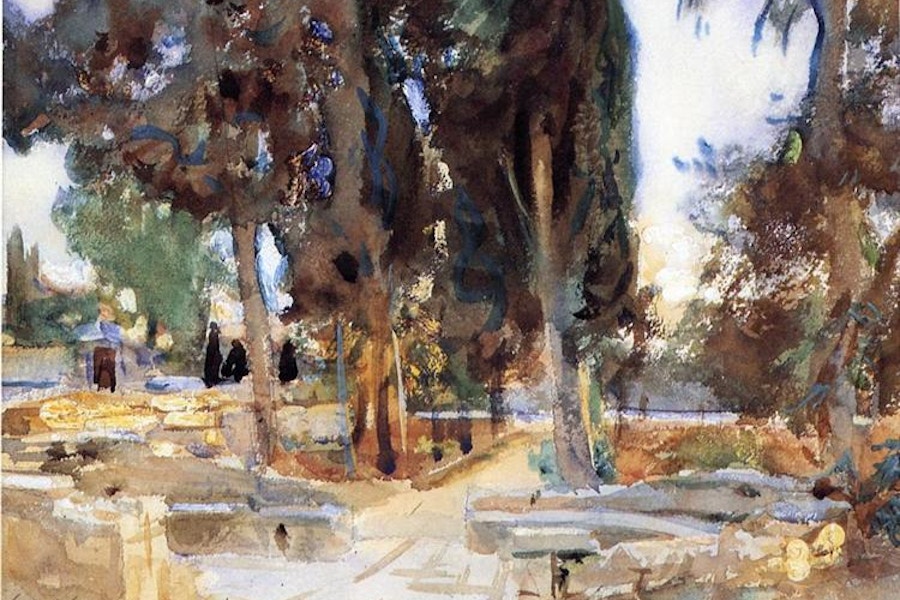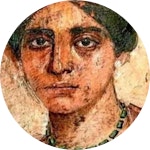Introductory Note:
Somewhere around the year 380 AD, a Spanish-Roman woman named Egeria (or Etheria) took a pilgrimage to the Holy Land. Egeria traced Jesus’ journey to the cross along with fellow worshipers, pausing at key places (“stations”) for Bible readings, prayers, and hymns. Her letter to friends back home detailing the experience is the oldest known description of a pilgrimage and gives us a little window into early Christianity and the birth of Holy Week liturgical practice.
Grace Pouch
Content Manager
Maundy Thursday
Mass celebrated twice
On the fifth weekday everything that is customary is done from the first cockcrow until morning at the Anastasis, and also at the third and at the sixth hours. But at the eighth hour all the people gather together at the martyrium according to custom, only earlier than on other days, because the dismissal must be made sooner. Then, when the people are gathered together, all that should be done is done, and the oblation is made on that day at the martyrium, the dismissal taking place about the tenth hour. But before the dismissal is made there, the archdeacon raises his voice and says: “Let us all assemble at the first hour of the night in the church which is in Eleona, for great toil awaits us today, in this very night.”
…
Night Station on the Mount of Olives
And so everyone hastens back to his house to eat, because immediately after they have eaten, all go to Eleona to the church wherein is the cave where the Lord was with His Apostles on this very day.
There then, until about the fifth hour of the night, hymns and antiphons suitable to the day and to the place are said, lessons, too, are read in like manner, with prayers interspersed, and the passages from the Gospel are read where the Lord addressed His disciples on that same day as He sat in the same cave which is in that church.
And they go thence at about the sixth hour of the night with hymns up to the Imbomon, the place whence the Lord ascended into heaven, where again lessons are read, hymns and antiphons suitable to the day are said, and all the prayers which are made by the bishop are also suitable both to the day and to the place.
Stations at Gethsemane
And at the first cockcrow they come down from the Imbomon with hymns, and arrive at the place where the Lord prayed, as it is written in the Gospel: and He was withdrawn (from them) about a stone’s cast, and prayed, and the rest. There is in that place a graceful church. The bishop and all the people enter, a prayer suitable to the place and to the day is said, with one suitable hymn, and the passage from the Gospel is read where He said to His disciples: Watch, that ye enter not into temptation; the whole passage is read through and prayer is made.
And then all, even to the smallest child, go down with the Bishop, on foot, with hymns to Gethsemane; where, on account of the great number of people in the crowd, who are wearied owing to the vigils and weak through the daily fasts, and because they have so great a hill to descend, they come very slowly with hymns to Gethsemane. And over two hundred church candles are made ready to give light to all the people.
… then the passage of the Gospel is read where the Lord was taken. And when this passage has been read there is so great a moaning and groaning of all the people, together with weeping, that their lamentation may be heard perhaps as far as the city.
Return to Jerusalem
From that hour they go with hymns to the city on foot, reaching the gate about the time when one man begins to be able to recognize another, and thence right on through the midst of the city; all, to a man, both great and small, rich and poor, all are ready there, for on that special day not a soul withdraws from the vigils until morning. Thus the bishop is escorted from Gethsemane to the gate, and thence through the whole of the city to the Cross.
Good Friday
Service at Daybreak
And when they arrive before the Cross the daylight is already growing bright. There the passage from the Gospel is read where the Lord is brought before Pilate, with everything that is written concerning that which Pilate spoke to the Lord or to the Jews; the whole is read.
And afterwards the bishop addresses the people, comforting them for that they have toiled all night and are about to toil during that same day, bidding them not be weary, but to have hope in God, Who will for that toil give them a greater reward. And encouraging them as he is able, he addresses them thus: “Go now, each one of you, to your houses, and sit down awhile, and all of you be ready here just before the second hour of the day, that from that hour to the sixth you may be able to behold the holy wood of the Cross, each one of us believing that it will be profitable to his salvation; then from the sixth hour we must all assemble again in this place, that is, before the Cross, that we may apply ourselves to lections and to prayers until night.”
The Column of the Flagellation
After this, when the dismissal at the Cross has been made, that is, before the sun rises, they all go at once with fervour to Sion, to pray at the column at which the Lord was scourged. And returning thence they sit for a while in their houses, and presently all are ready.
Veneration of the Cross
Then a chair is placed for the bishop in Golgotha behind the Cross, which is now standing; the bishop duly takes his seat in the chair, and a table covered with a linen cloth is placed before him; the deacons stand round the table, and a silver-gilt casket is brought in which is the holy wood of the Cross. The casket is opened and (the wood) is taken out, and both the wood of the Cross and the title are placed upon the table.
Now, when it has been put upon the table, the bishop, as he sits, holds the extremities of the sacred wood firmly in his hands, while the deacons who stand around guard it. It is guarded thus because the custom is that the people, both faithful and catechumens, come one by one and, bowing down at the table, kiss the sacred wood and pass through. And because, I know not when, someone is said to have bitten off and stolen a portion of the sacred wood, it is thus guarded by the deacons who stand around, lest anyone approaching should venture to do so again.
And as all the people pass by one by one, all bowing themselves, they touch the Cross and the title, first with their foreheads and then with their eyes; then they kiss the Cross and pass through, but none lays his hand upon it to touch it. …
Station before the Cross: The Three Hours
And when the sixth hour has come, they go before the Cross, whether it be in rain or in heat, the place being open to the air, as it were, a court of great size and of some beauty between the Cross and the Anastasis; here all the people assemble in such great numbers that there is no thoroughfare.
The chair is placed for the bishop before the Cross, and from the sixth to the ninth hour nothing else is done, but the reading of lessons, which are read thus: first from the Psalms wherever the Passion is spoken of, then from the Apostle, either from the epistles of the Apostles or from their Acts, wherever they have spoken of the Lord’s Passion; then the passages from the Gospels, where He suffered, are read. Then the readings from the prophets where they foretold that the Lord should suffer, then from the Gospels where He mentions His Passion.
Thus from the sixth to the ninth hours the lessons are so read and the hymns said, that it may be shown to all the people that whatsoever the prophets foretold of the Lord’s Passion is proved from the Gospels and from the writings of the Apostles to have been fulfilled. And so through all those three hours the people are taught that nothing was done which had not been foretold, and that nothing was foretold which was not wholly fulfilled. Prayers also suitable to the day are interspersed throughout.
The emotion shown and the mourning by all the people at every lesson and prayer is wonderful; for there is none, either great or small, who, on that day during those three hours, does not lament more than can be conceived, that the Lord had suffered those things for us. Afterwards, at the beginning of the ninth hour, there is read that passage from the Gospel according to John where He gave up the ghost. This read, prayer and the dismissal follow.
Evening Offices
And when the dismissal before the Cross has been made… they go to the Anastasis, where, when they arrive, the passage from the Gospel is read where Joseph begged the Body of the Lord from Pilate and laid it in a new sepulcher. And this reading ended, a prayer is said, the catechumens are blessed, and the dismissal is made.
But on that day no announcement is made of a vigil at the Anastasis, because it is known that the people are tired; nevertheless, it is the custom to watch there.
So all of the people who are willing, or rather, who are able, keep watch, and they who are unable do not watch there until the morning. Those of the clergy, however, who are strong or young keep vigil there, and hymns and antiphons are said throughout the whole night until morning; a very great crowd also keep night-long watch, some from the late hour and some from midnight, as they are able.
Adapted from Pilgrimage of Egeria, M.L. McClure and C. L. Feltoe, ed. and trans.
(London: Society for Promoting Christian Knowledge, 1919). source
Image: Jerusalem by John Singer Sargent, 1905 – 1906 (public domain)
Text First Published December 0381 · Last Featured on Renovare.org March 2024


